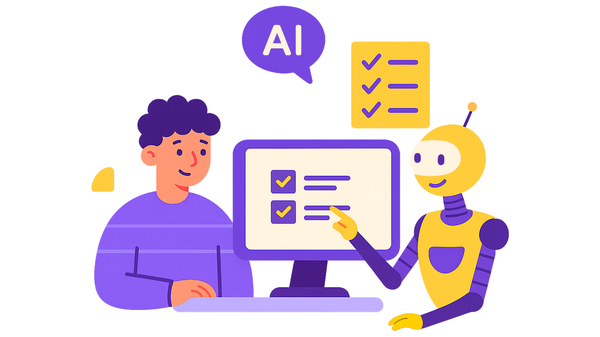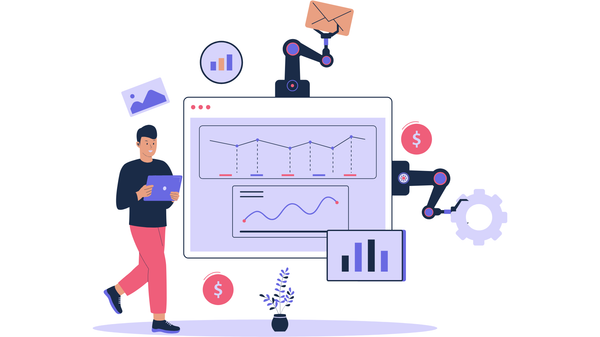How to Automate Interview Scheduling
Learn how to automate interview scheduling to save time, reduce errors, and create a better candidate experience with simple, no-code recruitment tools.

If you have ever spent an entire afternoon trying to coordinate interview times, you know just how draining recruitment admin can be. One person cannot make Tuesday; another suggests Friday; someone cancels at the last minute. Multiply that by ten candidates and three interviewers, and your week disappears.
It is not just frustrating — it is costly. Research shows that recruiters spend up to 30 per cent of their time on scheduling tasks alone. Every delay slows your hiring process, risks losing top candidates, and creates unnecessary stress.
The good news? You can automate interview scheduling easily, without technical skills or an expensive system. In this guide, you will learn how to set it up, the tools to use, and the best practices that keep the process human while eliminating repetitive work.
What Does Automated Interview Scheduling Mean?
Automated interview scheduling is the process of using software to manage interview booking, rescheduling, and reminders automatically.
Instead of manually emailing back and forth, candidates receive a link to choose a slot that fits their schedule. The system checks interviewer availability in real time, confirms the meeting, and sends calendar invitations instantly.
Why it matters: It saves hours of admin each week, prevents double-bookings, and provides a smoother experience for both candidates and hiring teams.
Automation is not about removing human contact. It is about removing friction so that conversations happen faster.
Why Manual Scheduling Is Inefficient
Manual scheduling may seem manageable for a few interviews, but it quickly breaks down as volume increases.
1. Too Many Variables
Each person has different personal commitments and sometimes time zones or calendar systems. Coordinating all of this manually leads to confusion and missed opportunities.
2. Delays in Response Times
Candidates expect immediate responses. Waiting 24 hours for confirmation can make your process feel outdated. In competitive markets, that delay is enough to lose great talent.
3. Human Error
Mistyped dates or forgotten time zones can cause embarrassing mix-ups. Automation eliminates these mistakes by using live calendar data.
4. Poor Candidate Experience
Slow, unclear communication reflects badly on your employer brand. Automated scheduling creates the professional impression that today’s candidates expect.
Benefits of Automating Interview Scheduling
Automation is not just about convenience. It drives measurable improvements across several areas of recruitment performance.
1. Time Savings
Automating scheduling cuts administrative time by up to 80 per cent. Recruiters can reclaim hours for relationship-building and assessment rather than calendar management.
2. Better Candidate Experience
Candidates appreciate instant confirmation and flexible rescheduling options. It shows respect for their time and sets the tone for a positive hiring journey.
3. Reduced Drop-Off Rates
A faster, smoother process reduces candidate ghosting. When scheduling is simple, candidates are more likely to stay engaged.
To understand how drop-offs affect hiring costs, read the Hidden Cost of Candidate Drop-Off for SMEs.
4. Fewer No-Shows
Automated reminders and calendar invitations reduce missed interviews significantly. Some teams see no-show rates fall by over 40 per cent.
5. Improved Internal Coordination
Interviewers receive automatic updates and reminders, ensuring everyone stays aligned without constant emails or spreadsheets.
How Automated Interview Scheduling Works
The process is simpler than most people think. Here is what happens behind the scenes.
- Set Up Calendar Integration
The scheduling tool connects to your team’s existing calendars, such as Google Calendar or Outlook. - Define Availability Rules
Recruiters choose which times are open for interviews, how long each meeting should last, and how many candidates can be booked per day. - Share the Booking Link
Candidates receive a link to book their own slot from the available times. - Automatic Confirmation and Reminders
Once a slot is chosen, everyone receives confirmation emails and calendar invitations automatically. - Sync and Update
If anyone reschedules or cancels, the system updates all calendars instantly to prevent conflicts.
Choosing the Right Interview Scheduling Tool
You do not need an expensive applicant tracking system to automate interview scheduling. Many affordable, no-code tools integrate easily with your existing setup.
Popular options include:
- Calendly: Simple, user-friendly interface for individual and team bookings.
- Google Calendar with Appointment Schedules: Ideal for small teams using Google Workspace.
- Microsoft Bookings: Works directly with Outlook and Teams.
- GoodTime and Cronofy: Advanced options designed for larger recruitment teams and panel interviews.
When choosing a tool, focus on:
- Integration with your email and calendar systems
- Time zone support
- Automated reminders
- Custom branding for a consistent candidate experience
For smaller organisations, see The Small Business Guide to Automating Hiring Without an ATS.
Step-by-Step: How to Automate Interview Scheduling
Follow these steps to build your own automated scheduling workflow — no coding required.
Step 1: Define the Interview Process
Map out every stage: screening calls, technical interviews, panel sessions, or final meetings.
Knowing who needs to attend and how long each session lasts helps you create accurate availability rules.
Step 2: Connect Calendars
Link your recruitment team’s calendars to your chosen scheduling tool. Most systems support live sync, meaning you will never double-book a slot.
Step 3: Create Templates
Set up standard templates for different interview types. For instance:
- 30-minute phone screen
- 60-minute panel interview
- 45-minute hiring manager session
Templates save time and maintain consistency across roles.
Step 4: Share Scheduling Links
Include the scheduling link in your candidate communication. You can embed it directly in automated emails or text messages.
For guidance on professional candidate messaging, see Write a polite rejection email with a positive tone.
This ensures communication stays friendly and brand-aligned, even when automated.
Step 5: Enable Automated Reminders
Set reminders for both candidates and interviewers. Most tools can send confirmations 24 hours and one hour before the meeting.
Reminders significantly reduce late arrivals and forgotten interviews.
Step 6: Track and Optimise
Monitor key metrics:
- Average time from application to interview
- Candidate satisfaction feedback
- Interview no-show rates
Continuous improvement ensures automation remains effective and aligned with your team’s workflow.
Integrating Scheduling with Other Recruitment Automation
Interview scheduling is just one piece of the recruitment automation puzzle. When integrated with other systems, the results multiply.
You can connect scheduling with:
- Automated resume screening: Quickly shortlist candidates before sending invites. Learn more in automating Candidate Screening.
- Automated candidate communication: Keep applicants informed at every stage with consistent messages.
- Onboarding automation: Once hired, move candidates directly into digital onboarding workflows.
To see how multiple workflows can work together, read 7 Simple Hiring Workflows You Can Automate in One Afternoon.
Common Mistakes to Avoid
Automation is powerful, but only when implemented thoughtfully. Avoid these common pitfalls.
1. Forgetting the Human Element
Automation does not mean impersonality. Add personalised notes to confirmation emails or schedule short check-ins to maintain a warm candidate experience.
2. Not Accounting for Time Zones
Global teams often overlook time differences. Use scheduling tools that automatically adjust to the candidate’s local time zone.
3. Poor Template Management
Outdated or inaccurate templates cause confusion. Review your settings regularly, especially if your interview process changes.
4. Lack of Internal Training
Ensure recruiters and interviewers understand how the automation works. Simple onboarding sessions prevent miscommunication and missed meetings.
Measuring the Impact of Automated Scheduling
To prove the value of automation, track its performance with measurable data. Key metrics include:
- Time saved per role
- Interview-to-hire conversion rate
- Candidate satisfaction scores
- Reduction in no-shows
- Hiring speed improvement
For a full overview of which numbers matter most, see 5 Recruitment KPIs Every SME Should Monitor Monthly.
Legal and Compliance Considerations
When automating candidate communication and scheduling, ensure compliance with data privacy laws. The UK GDPR and Data Protection Act 2018 require clear consent before storing candidate data.
If you are considering broader use of AI in recruitment, read Can ChatGPT legally be used to make hiring decisions? for a legal overview and compliance checklist.
How Small Businesses Benefit Most
Automation is often assumed to be a large enterprise tool, but small teams gain the most immediate advantage.
For SMEs, even small time savings compound quickly. By automating scheduling alone, small business owners can cut admin hours by half while maintaining personal candidate engagement.
To explore this further, read Using Automation to Save Time in SME Recruitment.
Real-World Example: The Five-Hour Hiring Week
A growing consultancy was losing candidates due to scheduling delays. After introducing automated interview scheduling and candidate reminders, their average time from application to interview fell from six days to one.
Recruiters saved over ten hours a week, candidates reported higher satisfaction scores, and hiring managers could focus on evaluating talent instead of chasing availability.
That efficiency translated directly into faster hires and stronger teams.
Ethical Automation: Balancing Efficiency and Empathy
Automation should never make recruitment feel robotic. Use it to streamline logistics, not to remove humanity from the process.
Consider adding personal touches such as:
- A short “welcome” note before the interview
- Post-interview thank-you emails
- A human follow-up after automated updates
The best automation is invisible — it simply makes your process seamless.
Future Trends in Interview Scheduling Automation
The next generation of scheduling automation will go beyond booking links. Expect to see tools that:
- Predict optimal interview times based on productivity data
- Integrate directly with video platforms for seamless joining
- Use AI assistants to handle rescheduling automatically
- Offer instant feedback loops for candidates
Automating interview scheduling is one of the quickest and easiest ways to modernise your hiring process. It saves time, eliminates stress, and improves candidate satisfaction — all without requiring technical expertise.
Start small by automating just one type of interview, then expand as your confidence grows. Within weeks, you will notice smoother communication, faster turnaround times, and happier candidates.
If you want tailored advice on implementing scheduling automation that fits your team’s workflow, book a call with our team. We will show you how to create a more efficient and human hiring process — no coding required.




